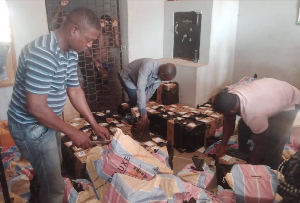Ghana’s ratification of the Catagena protocol on bio-safety should have a significant meaning to food policy and poverty reduction in the country. In particular, it will help to deal with future population increases and their impact on land tenure and management in the country. The Catagena Protocol on Biosafety is an international treaty that sets up a comprehensive regulatory system for ensuring the safe development, transfer, handling and use of genetically modified organisms within and across state borders.
By Ghana becoming a signatory to this agreement is a commitment that the country must uphold and take seriously if hunger and poverty are to reduce. The true test of this international agreement is how effective food and agriculture policy makers use the country’s membership in this regulatory regime as participants of the technological revolution and not as beneficiaries or observers.
The many food science and agricultural research agencies tasked with the responsibility of developing food and agricultural science programs and laying the foundation for an agricultural research policy framework to serve the food needs of Ghanaians, have failed. The failure is in a large part due to the non-integrated food production concepts that have been introduced by many and uncoordinated institutions and organizations involved in food and agricultural development schemes in the country.
Rather than implementing a holistic ecosystem and socially based programs in food production and agricultural research that are responsive to domestic, global food and agricultural production initiatives, food and agricultural experts in the country have opted for a compartmentalized, ad hoc and short term policy solutions by designating food production and agricultural research initiatives to established agencies that assume the primary responsibility of managing food and agricultural production programs in the country.
While most of these existing agencies have adequately satisfied their stated mandates, the current state of food and agricultural management programs in Ghana, suggests that the existing state management programs are not adequately responding to the current food challenges facing consumers. One needs only look at the accelerated and widespread increasing prices of food and agricultural products in the country, it is easy to conclude that the agencies responsible for food and agricultural production programs have failed to effectively manage the food and agricultural sectors.
The way forward is to demand a new navigational nudge that will amalgamate the many food production and agricultural research agencies into a single agency to collate and coordinate various knowledges of traditional, modern food and agricultural production technologies to help meet the food production needs of the country as well as her trading partners. Biotechnology is after all to improve on already existing food and agricultural technologies to produce higher yields. Ghana’s traditional fermentation and cross breeding programs alone, when well developed could make the country competitive in the food and agricultural science revolution and help secure for the country a respectable share of the genetic food and agricultural products market.
The promotion of biotechnology should incorporate educational programs to inform farmers about the seriousness of land fragmentation in food production programs. Organic food production from small and marginalized farmlands can be destructive to the ecology of the farm and at the end make the food production processes unsustainable. In Pakistan, the population is projected to increase from the current population size of 156 million to 345 million in 2050 but the average farmland will shrink from 0.08 hectares to 0.03 hectares (the size of a tennis court). Ghana faces a similar fate if the problem of land division and subdivision continues.
Population growth affects the acquisition and availability of farmlands more than anything else. When a farm passes from one generation to the other, it is subdivided between the wife and the children. The high rate of population growth in developing countries and the associated farmland fragmentation-taking place, available arable lands for food production are shrinking and that makes it difficult for farmers to produce enough food to feed the hungry. Between 1970 and 1990, the Indian government recorded 49 to 82 million small farmlands with less than 2 hectares (5 acres) in farm size. If the trend continues these shrinking farmlands will not be able to support a society expected to add about 515 million people to its current population of 1 billion in 2050. Therefore the question that arises is how can such traditional and cultural practices of land division and subdivision from one generation to the other change to improve land availability to increase food production to reduce hunger and poverty in malnourished communities?
In African countries such as Nigeria, the current population figure of 111 million people is projected to increase to 244 million in 2050. The per capita farmland will shrink from 0.15 hectares to 0.07 hectares and that will make Nigeria’s current precarious food production prospect far more difficult. Ghana is expected to add on additional 45 million people by the year 2050 and the average farm size will fall from 0.25 to 0.09 hectares per capita. This is attributed to the country’s tradition and custom, which require the holder of the land title to divide the land in equal proportion among male and female children upon his or her death. The practice of land division and sub-division between generations has contributed to extreme land fragmentation and increasing landlessness in a country where large farmlands promote productive food systems. These cultural practices complicate the efforts to expand food production.
While Genetically Modified (GM) food and agricultural crops would help to increase global food supply, it has the potential of limiting access to low- income earners in developing countries. Many agricultural organizations such as the Food and Agricultural Organizations of the United Nations (FAO), have argued that the biotechnology industry would not contribute to food security because it would deepen the economic inequalities inherent in the global food trading system by reducing access and affordability to low income consumers, which clearly emerge as the major cause of the disparities evident in regional food production and delivery systems.
But the prospect of adding 80 million or more people each year to the global population over several decades is a problem facing world agriculture and its ability to produce enough food to sustain present and future populations. In each of the three world food systems, croplands, rangelands and oceanic fisheries, the production increased dramatically over the last half of the twentieth century but output in all these three areas have declined considerably between 1950 and 2000. Croplands expanded from 631 million to 1,860 million tons and grain harvest increased from 247 kilograms to 342 kilograms per capita, which outstripped human population growth but production per person reduced to 308 kilograms in 2000.
The food insecurities in Ghana are a problem that requires changes in the way food and agricultural products have been produced in the past. More than 75 percent of people in the country are not eating adequately and over 80 percent of children are not getting access to adequate food to help them develop their mental and physical potentials. In addition to the economic crises in the country, it is estimated that Ghana will not be able to contain her population growth rates by 2050, if current food production programs are not improved to respond to the country’s current and future food demands.
The government must now take the bold step of producing enough food to reduce hunger and poverty in the country. Development cannot be promoted on empty stomachs and neither could corruption be reduced in the midst of widespread hunger and poverty. This means that our cultural practices also need an overhaul, as our land and labor must now compete in the genetic science economy. The socio-economic future of the country provides us with pragmatic alternatives and choices, no more excuses but to move forward as a country and prove to the world that Ghana is capable of addressing the problem of hunger and poverty, as are already known.
The biotechnology industry is an important contributor to food and agricultural crop production because of the use of modern scientific methods to help boost global food production. The food production successes by the industry have resulted in an upsurge of private sector investment in agricultural biotechnology. The industry has demonstrated that conventional agriculture lacks the capacity to produce enough food to meet global food security needs and that food and agriculture policymakers can develop an effective subsidized and distribution system for farmers to make GM foods and agricultural products a valuable contributor in producing affordable, accessible and available supply of food to feed Ghanaians and those beyond her borders.
Hunger and poverty reduction must be addressed by integrating modern agriculture with the traditional food production system and to make sure that food and agricultural varieties, which were not part of the traditional food system are introduced into the country to expand Ghana’s food and agricultural product base. Such a strategy would not only reduce the importation of foreign foods and agricultural products into the country but use the foreign earnings saved to rebuild the country’s degrading school system and to provide children with affordable, accessible and available healthcare services. I have argued that the future belongs to those who plan and prepare for it and the character of a nation is measured in the way that country treats her children. No country could realize her development goals while the collective will of her children are challenged.















